One of the things that I have always found interesting about the upsizing of GM’s B and C-body cars for 1971 is the timing. They got bigger and heavier just as engines started to become less powerful, thanks to the Clean Air Act (’70), longer and heavier, still, with mandated five MPH bumpers (’73), and a lot more expensive to operate thanks to an oil embargo (’73) and its resulting high fuel prices. OK, so GM’s crystal ball didn’t always get the best reception but it seems that a perfect storm of obstacles arose at the dawn of the ’70s. Regardless, cars like this 1971 Oldsmobile Ninety-Eight were still impressive and commanding, and this Hilton, New York example has some expansive eye-popping appeal. Tempted buyers will find it here on eBay where it’s available for a current no-reserve bid of $5,600 with seventeen bids tendered so far.
At 226.1 inches in length, 79 inches in width, packing 4,500 lbs. while riding on a 127″ wheelbase, this Olds is definitely a whammer-jammer! Maybe it’s the spotless Cameo White finish but this baby seems larger than the dimensions would indicate. The chrome, trim, paint, and glass are all flawless on this claimed to be “one-family-owned” hardtop. The seller has emblazed the production stat of 8,335 across the top of the windshield and that does appear to be true based on my research source, though I wouldn’t consider that number to put this Olds in rare territory. And, one has to realize that volume only applies to the Holiday coupe, there were another 14K “Luxury” coupes, just a different rim level, assembled too.
One thing not photographed (always a mistake), and in spite of all of the included listing images, is the 320 gross HP, 455 CI “Rocket” V8 engine. The seller refers to it as, “A true survivor that runs amazing“. The only transmission available was the Turbo-Hydramatic 400, three-speed unit and that’s what’s in place here.
No doubt about it, luxury and near-luxury dash and instrument panels had become considerably more pedestrian in the ’70s – say compared to how one from a 1951 Ninety-Eight would present itself. But what’s in place here is appropriate for a car of this stature and it shows itself well. The upholstery, carpet, headliner, door panels, and dash pad look fine for a 52-year-old cruiser that has experienced 109K miles but I must admit that the front seat covering seems wrinkly. The A/C system is claimed to be ice cold and it appears that the original Delco radio has been swapped for a newer cassette-integrated (can’t be a whole lot newer!) unit.
If you’re looking for a car that will eat up the road, your steed has arrived, yowsir! This is an impressive piece of machinery, not only for its largesse but also for its renowned Oldsmobile quality. The wheels hadn’t started to fall off of GM’s stature in ’71 but it was steadily moving in on the time when the debate would become what was falling faster, the quality or the market share (think ’71 Vega). But forget about all of that with this fabulous Ninety-Eight, it’s selling at no reserve and it just might be a big, bad, beautiful buy, right?
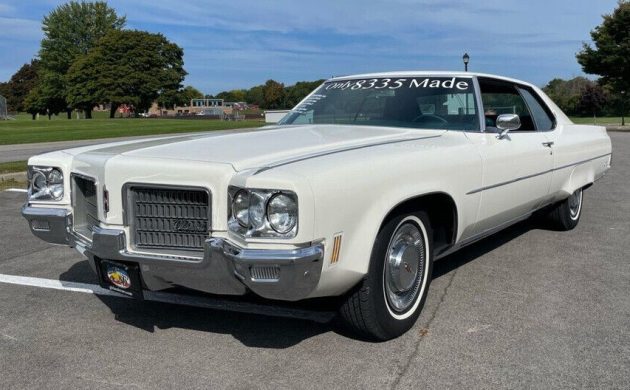
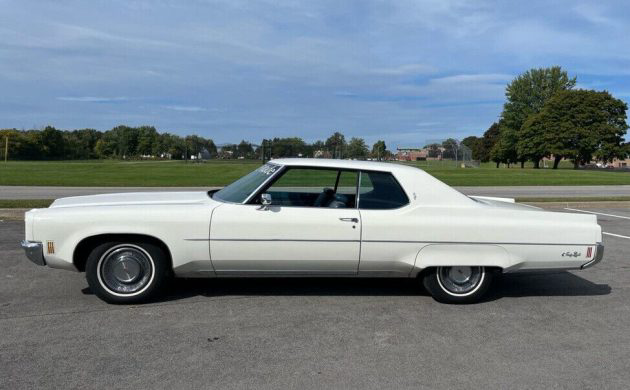
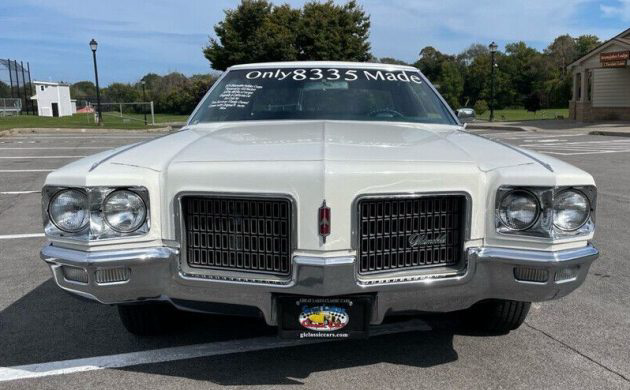
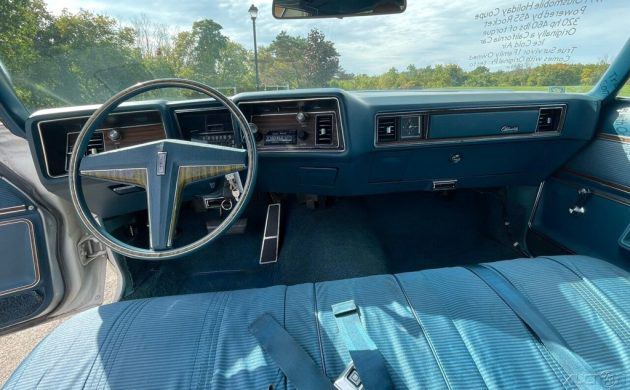
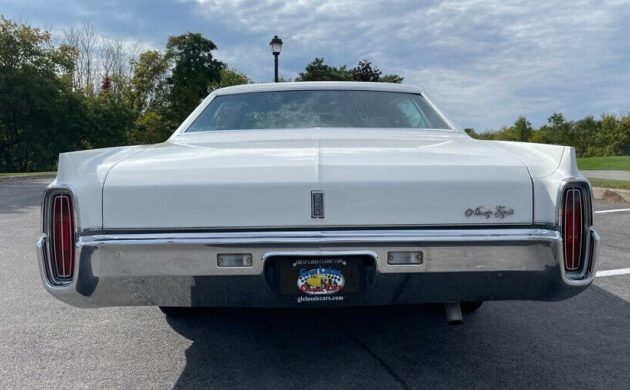


Great write-up Jim, very insightful. It’s weird how there was an oil embargo in the early 1970s, and yet all the cars of the era had totally plastic interiors. Maybe all the oil was being used to make plastic, so there wasn’t enough to make gasoline!
Even as a young lad of 13 back in ’71, I could see that GM was really getting cheap with sheet metal, interiors etc. Later on, I learned my lesson with GM engines. 1971 was truly the last of the decent GM cars. I do love my ’63 Riviera, though.
The plastic interiors came before the oil crisis and were for safety reasons – meant to absorb impacts from the passengers in a crash and cause less injury than the previous interiors.
Regardless, this is one nice 98 and presents very well, especially for 109K miles. It was cared for by someone.
I’d like to bid 6,000.00..I can’t remember what the current bid is..Ill raise it if that’s not enough…
Prior to plastic interiors and crush zones (and seat belts for that matter), when a person got into an accident, they just hosed out the interior and sold the car to the next guy.
I like your dark sense of humor.😆
That’s an old Jay Leno joke talking about his 50’s Buick if he got into an accident.
That joke was funny when I heard Jay Lenno tell it 30 years ago.
Indeed. Many people do not realize the origin of plastic, which is the same oil that everybody and his uncle know as a fuel source. I dare say that, especially now, the use of oil to make plastic dwarfs by a wide margin the use of oil to make fuels.
Man this is nice. My brother had the 4 door of this in maroon but only had the rocket 350. Still didn’t get much more comfortable than this and being a 2 door in this good of shape, someone’s gonna get a good deal.
I had a 71 four door with the 455 ci I purchased for $50 back in 1986 when I was in college. Great car but for the fact that I went broke putting gas in it at 86 cents/gal.
I believe the owner has a seat cover on, and this tank is awesome! Just the right amount of menace in that front end and good looking from any angle, with a proper color….
I had a ’73 4-door LS red with white vinyl roof and red interior. Coincidentally, I bought mine with the same miles. Mine was loaded not like this one. I had it 2 weeks before I noticed the clock on the front seat back for the rear seat riders!.
Have seen few 98s of this vintage without p/w & or p/seats at least.
Nice looking car with the white finish though.
I really, really like this cruiser.
Perhaps someone finally decided to be honest and list the actual milage.
109,000 instead of the usual 9,000 miles. The milage hasn’t hurt it at all anyway.
Whoever buys this sure is getting a straight looking car.
Best of luck to the buyer.
Just my oponion!
Its a nice car. But Id pref e r the earlier smsller 98 with the 425 engine.
More power better gss milesge ..as if…
But the main thing was the 425 engine was sn overswuare motor made more hp plenty of torwue and had a much more durable reciprocsting assembly.
I believe t he 425
was available in 98s up to 380 hp. 390 hp was avlajlable for the 67 ztornado and 400 hp avsilable in the Tornado with the cold sir package.
I had the pleasure of driving a 68 Tornado from Las Vegas to LA.
The csr didc d xactly whst is was supossed to do. It ran effortlessly at 100 mph all the way to the Californis state line and ctuised in the rest of the way at 80.zero driver fatigue zero a n usebof a grest engine and car. Thats what they were made to do. And yes.
. I LISTENED TO i Cant Drive 55 twice during thectrip.
Can we have that in English please ?
ha ha ha lol
You’re slurring your text , Sir.
Translation?
Please, repeat in English
My dad had a 73 white olds.98.car like this one..4 door I think…man..it was a big old car..drove like a tank…455 motor..red interiors .good for interstates..I drove it to Dallas tx once from tenn…big old car..big old drive…nothing like them..he traded for Olds to get rid of a 69 mercury that had a rod knock…..455 motor was a good running motor..big old front seat..
I had a ’72 Ninty Eight LS 4 door. Dark blue body and vinyl top, cream interior. I had the 455 cu in and it needed it. These were very heavy cars with very flimsy bumpers. Had it towed from the front, the bumper bent. Had it towed from the back. The bumper bent. Learned fast to have it go flatbed.
My first car was my dad’s 1963 Ninety-Eight. My brother rebuilt the engine. I paid $300 in 1974, drove it for two years. My dad’s next car was another land yacht-1972 Buick Electra 225(duece and a quarter). I have always had a big, American car like a couple of Caddy’s(Sedan d’Villes).
Thanks, dad for introducing me to luxury rides, American style.
You should never, ever, tow a car from the bumper. We’ve had a 72 98 Regency in the family since ’74 and the bumpers are rock solid.
I don’t understand the comments about cheapening out on sheetmetal and flimsy bumpers. ‘71-76 GM full size cars across the board have very robust bumpers and no shortage of good thick and strong sheetmetal. I’ve owned a variety of them, all the different GM makes except Buick, and these are strong, heavy cars. Demolition derbies have always disgusted me for their outrageous needless destruction of great cars, but these cars all excelled at them because they were so overbuilt and strong.
The Oldsmobile interiors are a little disappointing. My ‘71 Delta 88 Royale convertible has a plastic dash that feels and looks much cheaper than the ‘71 Pontiacs had. Never understood why Olds went the direction they did with them. The Pontiac interiors of that time were the most stylish of the BOPs and had excellent build quality. Cadillacs of course were always a step above all three.
This looks like a great car, and would be a phenomenal cruiser if the mechanicals match the appearance. Of course, they’re very easy cars to work on and parts are very readily available, so the typical front suspension rebuild it probably needs (among other things) is very easy and inexpensive to tackle. Find some NOS oil shocks to install at all four corners and you will retain the GREAT original ride quality these cars all had. Throw on some cheap parts store gas shocks and you will be very disappointed, assuming you know how one of these cars is supposed to ride. Finding oil shocks is not easy today, but is absolutely worth the effort and whatever additional cost they require. NOTHING made today compares to the ride on these cars when they’re set up as they were off the assembly line. There are some very nice cars made today, but gas shocks and struts and lower profile tires will never provide the kind of true floaty ride these cars offered.
Agreed – we had a 71 Custom Cruiser and when Dad put gas shocks on it, it changed the ride for the worse.
Great cars, the 71 Olds. The 455 likes to eat starters and the thing that kills most of them is the Delrin timing gear wearing out. Seat vinyl is a bit thin compared to my old 68.Fairlane. Those are the only issues I have with the 98s. Someone is likely to get a straight deal. 👍
Just about every American V8 of the time period had nylon camshaft sprockets that would prematurely wear and disintegrate. I’ve always shaken my head at the idiocy that was to use those and create a needless failure point with no tangible benefit whatsoever.
My dad had a 73 white olds.98.car like this one..4 door I think…man..it was a big old car..drove like a tank…455 motor..red interiors .good for interstates..I drove it to Dallas tx once from tenn…big old car..big old drive…nothing like them..he traded for Olds to get rid of a 69 mercury that had a rod knock…..455 motor was a good running motor..big old front seat..
73 through 76 GM cars rotted like wet tissue paper, 73 probably the worst of those years.
I have no idea where you get that impression. There is no difference whatsoever in the steel, coatings or corrosion resistance of any of the full size cars from ‘71-76. All used galvanized steel, similar construction methods and the same kinds of coatings.
These kind of anecdotes are usually based on singular experiences with cars that lived very different lives with very different levels of care compared to others. Reality is that across the board the GM full size line became much more resistant to corrosion starting with the new body style in ‘71. A lot of that is the transition to the use of galvanized steel.
Every car rusted badly in the rust belt. From a B210 to a Bentley. They ALL turned to dust in a decade or less in most cases.
Well, that’s not 100% accurate. True, they were robust compared to cars nowadays, even to cars of the 1980s; but “controlled crush” was already an automotive application by this car’s year. I clearly remember the front body clips of 98s (even contemporary Lincolns), the body part above the bumper, being made of fiberglass, as a response to Nader’s influence, done to absorb some degree of impact in a front-ending. Lincoln started the “controlled-crush” bit in ’68, by softening the metal at the fronts of the cars…which I suspect began to compromise the integrity of the unibodies, maybe convincing them further to ditch unibody construction after ’69 in favor of the old-school body-on-frame construction (which also happened to be cheaper in construction costs).
This looks to me that it’s a clean car with low miles. These are hard to find in good shape. Great read as well
I Guess That There Weren’t Any Tow Trucks In Your City That Had A Wheel Lift Tow Mechanism Available?
I will never understand why GM needed 5 brands that were basically all the same cars under the skin. I understand that Oldsmobiles were one of the very first brands made at the time when cars were just beginning to take over the world. I was just a kid in the mid-60s and already on my way to being a total Gearhead. I was able to see the cars GM was building were all the same. Sure they all had different names but that was all that made them different. Buicks and Oldsmobiles were just around as names to justify the different prices GM had set up as a way to meet people’s finances and status symbols. I always liked the Pontiac brand, they had great looks and and a reputation for performance. That said, this Oldsmobile managed to actually look like what an Oldsmobile should look like, especially the taillights. When I was in my teens, I had a detail shop so I knew cars. One of my clients had a 98 just like this one, except it was a late 70s model, year. It was a nice car, but it had the 350 cubic inch that was converted to a diesel. What a horrible thing to do. It was loud, big, and dirty. Tons of black smoke and it never ran right. It was one more big mistake that GM made. What a mess. There are so many GM mistakes I’ve lost track of them all. Other than being a major employer, GM should not be able to make cars. Just because GM is so big it doesn’t mean they are good, and GM is not good. GM doesn’t build cars that are designed well, or reliable, they build cars to make big profits, which they don’t even do that well. I’m a Ford fan, and I like Chryslers. But I have never bought a GM car, and I never will, and I know I’m not missing anything by not owning a GM car or truck. I can’t even support them for at least being part of the Big Three. GM is much smaller than their once were, and in time they will be even smaller than they are today. That’s really sad, because they have the money and the might to build much better cars than they ever had.
The idea that GM didn’t make great cars is completely and definitively disproven by the fact that the public chose to buy more of them, as well as the fact that so many GM muscle cars and classics are so valuable and sought after today. The ‘71 GM offerings were indisputably superior to the competition from FoMoCo, and arguably superior to the Mopar offerings just the same. Styling is personal preference, but build quality is tangible and measurable, and GM’s offerings in ‘71 were absolutely superior to FoMoCo’s.
For every ‘71 LTD, Marquis or Continental you see on the road today, you see several comparable GM offerings. Their respective values prove the disparity in desirability today as well. Your anti-GM hate is based on nothing factual or tangible.
They were all VERY DIFFERENT under the hood with the Buick 455 being the most powerful! I don’t care what the books claimed about horsepower ratings, the 70 Buick 455 Stage 1 would chew up a Pontiac 455 SD and the Olds 455 HO in the same size car! It even whooped a 70 Chevelle 454 LS6 which was rated at almost 100 more horsepower! It did the same thing to a 429 Boss Mustang, and a 440 6pack Roadrunner which were ALL rated at more HP than the 70 455 Buick! I was never a Ford guy because I had some serious money in a 428 CJ Galaxy that I thought was the real deal until a teenager in a 350 4 barrel Nova Humiliated me in front of 200 people and then a 77 Volare 360 4 barrel kicked my ass the next night! You can’t win a race with a Ford, unless you only race other Fords! I’ve owned many different cars from the Big 3 and from my personal 43 years experiences I’ve found that a GM is the most bang for the buck than any of the others. Back in my early days if you got 80k miles out of a 302 Ford it was amazing so I never liked them from the start!
The Stage 1 would often shine in street races but not as often in the quarter mile.
The fact is, in this 1971 time period, all of the GM cars were using engines designed and made by their own division. The 3 455s and the 454 were separate engine families. The same goes for all 4 350s. The one exception to this at the time, was that all 6-cylinder A body cars used the Chevy 250, as did the Pontiac Ventura II. It also used Chevy V-8s. God back a little farther, and late 50s – mid-sixties B and C cars used various frames underneath. They used various spring setups, and even torque tubes in some instances. The level of differentiation among the GM 5 was far more than at Chrysler Corp. or Ford Motor Company in the same time period. Resale value (Impala, Galaxie, Fury for instance) and miles rolled up at junkout also tended to favor GM in those days too. The press talked about these things back then.
Nice, maybe but too big for me and I’m 6’6″, 300 lbs. I’ll take a Kia Rio any day over one of these. Been buying Rios since day one. None stopped running with under 300,000 miles. They rusted out before they wore out. All 40 mpg. Always a manual transmission.
We get that you hate American cars. Shill for your Asian masters someplace else.
Who the hell cares?
I truly hope you never have one of your Rios hit by anything the size of this Oldsmobile because your 40 mpg will have just gotten you killed! Stuffing a man your size in a Rio will guarantee your fate at a rather slow speed leaving the Olds driver running in circles yelling for someone to call 911!
As Khan said to Chekov….”Why are you here?”……
71 GMs do have the softess bumpers and could be damaged easily if you did not hook the sling correctly. Rollbacks were in their infancy when these were new. Many cars were damaged by inexperienced tow operators. I had a 70 GS Buick that the guy bent the front bumper and busted the grille while towing it. This is a base unit, I.E. crank windows, no vinyl top, “a good thing” or it would likely be a convertible in hiding. A great time when you could get any style of car tailored to your budget and taste. White makes these look enormous, though they are the biggest ever. A few passed through my hands but I always seemed to end up in an Eldorado or Impala, which I retain to this day. A very nice survivor here and 109k is nothing for a well cared for copy. Oils and additives have improved significantly and make these dinosaurs purr.
Did I miss something? The party selling this very nice car is a dealer yet no photos of the engine compartment, the trunk, or the frame and body underneath yet there’s a photo of one of the fender skirts.
This is certainly a lovely car and shows how handsome the design is without the optional vinyl roof. I hadn’t realized before seeing this car that it was possible to buy a Ninety Eight or any General Motors C body car without power windows and door locks. Thanks for including this remarkable car.
It’s funny, the only ’71 98 I’ve ever bought had a price of $75!!
A buddy wanted the power window regulators and power seat frame for a Suburban he was working on, so we split the price.
I took what was left and made it through three 250 lap Enduro races, before selling the engine/trans with a ’72 Cutlass Supreme convertible with a knocking 350.
AH, the good ole’ days. Did quite a bit of that!
This is a beautiful car. I love small English and Italian sport cars, and American muscle (I’ve had many), but now I have a 72 Coupe de Ville and a 63 restomoded Galaxie 500. The latter never comes out to play, but the CdV is my weekly driver, with 40K miles, and its a beauty – people of all ages, sizes and shapes love it. I’m too old and tall and fat for the small stuff now, so it suites perfectly. THIS is a car I’d buy, and be happy to have it.
In 1984 I bought a 1968 Oldsmobile 98 for $300. The car was loaded with all the options and drove like a dream. But it really drank fuel. This was my wife’s daily driver for a few years. I had a company Toyota pick up truck. My wife wanted something smaller so we sold the Olds for $500 and bought a new 1988 Toyota Corolla station wagon. I really liked that Olds but with what we saved on fuel cost made a big dent in the Corolla’s monthly payment. I like this Olds but have no where to keep it inside like it deserves. Someone is going to get a really nice ride. GLWTS.
The seller speaks of the low production figure. Being the base model two door is all you need to know. Most buyers stepped up to the LS and got the standard power windows and driver seat. Kinda like a deVille over a Calais. As for me, I like it. No vinyl roof looks clean. The tilt and telescoping steering wheel is cool especially on the base car.
I like the big luxury cars of this era and the things that people are doing to them today makes them look even better. Nice 98
When I was a kid I had a hard time differentiating Olds 98s from Cadillacs; of course, as I grew up, I then learned how to tell the differences between the two. Even so, I still see 98s as a sort of “Cadillac-Light,” which makes sense as Oldsmobile was one step below Cadillac in GM’s car class structure. They were about as close to Cadillac as LaSalle was until 1940 (though LaSalle actually used Cadillac drivetrain components, which Oldsmobile did not). At first glance I would tend to mistake a 98 for a DeVille. I did not make that mistake with the Buick Electras, however; those cars were pretty easy to identify despite having the same underpinnings.
Actually, the hierarchy in the G.M. lineup of makes was Cadillac, Buick, Oldsmobile, Pontiac, Chevrolet.